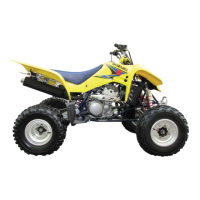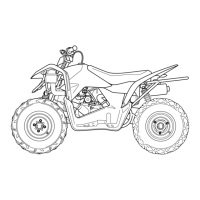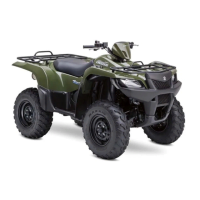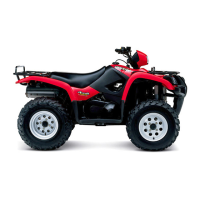4-21
RIDING IN COLD WEATHER
Pre-ride Inspection
Check that the throttle and all control
levers move freely. Make sure that the
footrests are free of ice or snow.
Move the ATV forward and backward
to check that the wheels roll freely. If
you cannot move the ATV, the tires
may be frozen to the ground, or the
brakes may be frozen to the wheels. If
the tires are frozen to the ground,
pour warm water around them to melt
the ice. If the brakes are frozen, bring
the ATV to a warmer area to thaw out
the brakes.
After the engine has warmed up,
check the brakes. Do this inspection
on level ground and do not exceed
walking speed. Be sure to check the
operation of both front and rear
brakes. If the brakes do not work ade-
quately, stop riding the ATV. Bring the
ATV to a warmer area to allow the
brakes to thaw out. After the brakes
thaw, dry them by applying them sev-
eral times while riding slowly. If the
brakes do not regain full stopping
power, have your local Suzuki dealer
check them before you continue riding
your ATV.
Any water that enters the brakes
while you ride may freeze after you
park your ATV. The frozen water can
prevent the wheels from turning or the
brakes from working. After riding
through water, mud, snow, or slush it
is important to dry the brakes before
parking the ATV. To dry the brakes,
apply them several times while riding
slowly. Before your next ride, be sure
to do a Pre-ride inspection as
described earlier in this section.
CAUTION
Using engine power to free up fro-
zen wheels can damage your ATV.
Severe damage to the drive train
may occur if you use engine
power to free frozen wheels.
Before riding, manually move the
ATV forward and backward to
make certain that all wheels roll
freely.
WARNING
Operating the ATV without a prop-
erly functioning brake system can
be hazardous.
Wet or frozen brakes will increase
stopping distance. This will
increase your chance of having an
accident.
Be sure to inspect the brakes
before each use of the vehicle in
cold weather as described above.
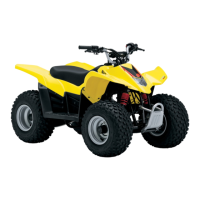
